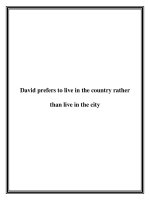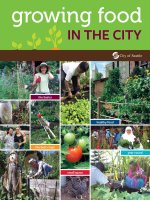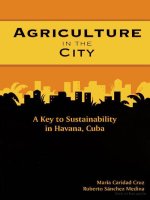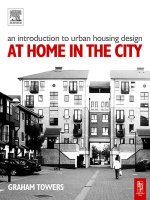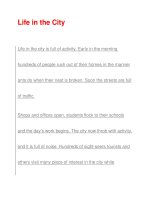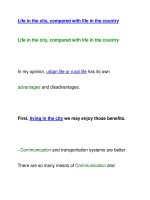timber in the city
Bạn đang xem bản rút gọn của tài liệu. Xem và tải ngay bản đầy đủ của tài liệu tại đây (2.78 MB, 13 trang )
TIMBER IN THE CITY
1www.acsa-arch.org/competitions
U
R
B
A
N
H
A
B
I
T
A
T
C
O
M
P
E
T
I
T
I
O
N
TIMBER
IN THE
CITY
TALL WOOD TOWER IMAGE: MGA | MICHAEL GREEN ARCHITECTURE
WHAT?
Entries should interpret, invent, and
deploy numerous methods of building
systems, with a focus on innovations
in WOOD DESIGN.
WHERE?
The design challenge is to envision
a wood mid-rise, mixed-use complex
with affordable housing units in RED
HOOK, an in-flux, and increasingly
vibrant Brooklyn neighborhood.
CONTENTS
Introduction/Challenge 02
Program 04
Guidelines 07
Recourses 10
Competition Organizers 12
TIMBER IN THE CITY
2www.acsa-arch.org/competitions
INTRODUCTION
The Association of Collegiate Schools of Architecture (ACSA) is pleased to announce TIMBER IN THE CITY: Urban
Habitats Competition for the 2012-2013 academic year. The competition is a partnership between the Binational
Softwood Lumber Council (BSLC), the Association of Collegiate Schools of Architecture (ACSA) and the School of
Constructed Environments at Parsons The New School for Design (SCE).
The program is intended to engage students and recent graduates, working individually or in teams to imagine the
repurposing of our existing cities with buildings that are made from renewable resources, offer expedient affordable
construction, innovate with new and old wooden materials, and provide healthy living / working environments.
THE CHALLENGE
The competition challenges participants to design a mid-rise, mixed-use complex with affordable housing units,
a job training/educational facility, a center for innovative manufacturing of wood technology, and a distribution
center. The project site is in Red Hook, Brooklyn a neighborhood in some flux, cut off from much of Brooklyn
geographically, yet increasingly vibrant.
Aspiring to regenerate a dissipating urban manufacturing sector and address the housing needs of New York City,
entrants will be asked to design a place for the creation of originative vocational opportunities embracing new
wood technology. Entrants will be challenged to propose construction systems in scenarios that draw optimally on
the performance characteristics of a variety of wood technologies.
Red Hook. Online image. Flickr.
TIMBER IN THE CITY
3www.acsa-arch.org/competitions
1
ST
PRIZE
:
STUDENT $7,500
2
ND
PRIZE
:
STUDENT $5,000
3
RD
PRIZE
:
STUDENT $2,500
RECENT GRADUATE AWARD:$10,000
FACULTY SPONSOR $2,500
FACULTY SPONSOR $1,500
FACULTY SPONSOR $1,000
TIMBER
The competition will challenge participants to interpret, invent, and deploy numerous methods of building systems,
with a focus on innovations in wood design on a real site. For thousands of years, solid wood has been used as a
building material. Timber is an ideal green building material: it is well suited for a broad range of structural and
aesthetic applications, it offers high performance characteristics; and wood is an economic driver to maintain
forests and protect jobs in our communities.
CRITERIA FOR JUDGING
Criteria for the judging of submissions will include: timber/wood as the primary structural material, creative and
innovative use of timber/wood in the design solution, successful response of the design to its surrounding context,
and successful response to basic architectural concepts such as human activity needs, structural integrity, and
coherence of architectural vocabulary.
SCHEDULE
MARCH 6, 2013 Registration Deadline
MAY 22, 2013 Submission Deadline
JULY 2013 Winners Announced
AWARDS
Winning students, their faculty sponsors, and recent graduate/emerging professionals will receive cash prizes
totaling $30,000. The design jury will meet July 2013, to select winning projects and honorable mentions.
Winners and their faculty sponsors will be notified of the competition results directly. A list of winning projects
will be posted on the ACSA website (www.acsa-arch.org).
Image provided by: naturally:wood
TIMBER IN THE CITY
4www.acsa-arch.org/competitions
PROGRAM
The diversified program proposes several spatial conditions, span distances, and environmental criteria in order
to elicit a diverse group of architectural compositions and technological solutions that incorporate the use of
differing structural, framing, and detail-oriented components. Such conditions may be:
• Vertical mid-rise framing (i.e. Mass Timber Systems such as CLT and FFTT)
• Interior partitioning (stud framing or modular panelized systems)
• Exterior cladding (modular assemblies)
• Long-span structure (glulam beams, truss joists, or other composite members)
Following are the building program requirements:
WOOD
PRODUCTION
RESIDENCE
DIGITAL
PRODUCTION
BIKE
SHARE +
SHOP
Residences in this project are a mix of small units for single or double occupancy and
larger, family-based units with more than one bedroom. All apartments must have
exposure to natural light and air, as well as rooms that meet minimum size requirements
of the New York City Department of Housing Preservation and Development (HPD)
< />Fabrication of wood or other associated componentry at a smaller scale will occur
here. This facility will be a cutting edge, digitally-based laboratory for the exploration
of manufacturing processes. While connected to and complementary of the larger
scale workshop and manufacturing facility, this facility will also be a training and
teaching facility with classrooms related to skill development in wood manufacturing.
Catalyzing urban manufacturing, these
WOOD
&
DIGITAL
Production facilities will be a cutting-edge
workshop and commercial venture relating small to large-scale building componentry. These facilities will be run by a
single umbrella organization and consists of a series of multi-scaled services related to production, work training, and
education. The umbrella organization will maintain and administer the entirety of these fabrication facilities. While
the individual facilities may be accessed separately and contain distinctly different functions, their complementary
nature needs to be taken under consideration in terms of design adjacencies as well as smart separation.
As Red Hook has limited public transit and is somewhat isolated from surrounding
neighborhoods of Brooklyn, a bicycle share hub and central repair shop is required
as an integral component of this new building.
The facility will host manufacturing equipment for assembly processes related to the
fabrication of elements for the construction of wood buildings. The facility will also
accommodate packing and staging areas in order to facilitate eventual shipping of
this material, locally and regionally.
TIMBER IN THE CITY
5www.acsa-arch.org/competitions
Studio 325 sqft 100 units 32,500 sqft
1 BD 650 sqft 35 units 22,750 sqft
2 BD 850 sqft 25 units 21,250 sqft
3 BD 1000 sqft 15 units 15,000 sqft
2,000 sqft
5,000 sqft
3,000 sqft
300 sqft
750 sqft
Workshop / Maintenance Area
Main Bicycle Storage
Shop Storage
Restrooms
Entry Ramp
Protected Bike Parking
3,000 sqft
Main Production Area 20,000 sqft
Research Workshops 3,000 sqft
Material Storage Warehouse 12,500 sqft
Showroom 2,500 sqft
Offices 2,500 sqft
Restrooms / Kitchen 500 sqft
Main Production Area 6,000 sqft
Workshops / Classrooms 2,800 sqft
Material Storage 1,500 sqft
Showroom / Exhibition Space 2,000 sqft
Offices 1,200 sqft
Laundry 750 sqtf
Recreation (indoor) 2,500 sqft
Lobby / Mail 1,500 sqft
Mechanical 4% 3,850 sqft
Circulation 10% 9,625 sqft
Parking 58 spaces
Mechanical 4% 1,640 sqft
Loading Dock 2000 sqft 2,000 sqft
Mechanical 4% 540 sqft
Loading Dock (may be shared w/ other facilties) 300 sqft 300 sqft
Residential Subtotal 96,250 sqft
Wood Production Subtotal 41,000 sqft
Bike Shop Total 14,050 sqft
Wood Production Total 44,640 sqft
Digital Production Total 14,340 sqft
Digital Production Subtotal 13,500 sqft
Residential Total 109,725 sqft
RESIDENCE
WOOD
DIGITAL
BIKE
GROSS SQFT 182,755
TIMBER IN THE CITY
6www.acsa-arch.org/competitions
The site can also be identified in New York City records as Block 606, Lots 5 & 10. The site is part of an 83,159
sq. ft. block that exists between Dwight and Otsego Streets as well as Beard and Van Dyke Streets. Refer to the
follow resources for more site information:
Site ID: < />Red Hook: < />red hook in new york city
SITE
Red Hook, South Brooklyn Waterfront, New York, is a
mixed income, residential and industrial neighborhood,
and an increasingly vibrant community. The project site
is across from a big-box furniture store and proximate
to Added Value, a major urban agriculture site. It is also
a few blocks from the Red Hook Houses, a significant
public housing development – one of the largest in
the city. Nearby are several major public amenities,
including the Red Hook recreational facility, the Red
Hook ball fields, and highly trafficked commercial
outlets, including a grocery store.
Red Hook inspired events depicted in the movies
“Red Hook Summer” and “On the Waterfront”. Red
Hook is a neighborhood in some flux, cut off from
much of Brooklyn geographically, yet highly active.
CODE INFORMATION
In general, please refer to the New York City code. Please
note, however, that in reference to timber construction,
one of the goals of this competition is to explore new
construction opportunities enabled by contemporary
timber technology that may not yet be anticipated or
fully embraced by the current NYC code. Each entry is
encouraged to understand the potential of contemporary
timber systems, drawing from available resources and
comparable code reviews from other jurisdictions and
governmental agencies, as they pertain to new timber and
wood systems, to inform the submitted design.
Also, please refer to the International Building Code and
the local zoning ordinance for information on parking
requirements, height restrictions, set backs, easements,
flood, egress, and fire containment. Accessibility guidelines
need to be followed; refer to the Americans with Disabilities
Act, along with the principals of Universal Design.
CONSTRUCTION TYPE
The design project must be conceived in structural timber. A strategy should be considered that evaluates a
method for taking advantage of timber’s properties and characteristics in order to conceptualize and propose a
critical evaluation of the design solution.
Red Hook Row House. Online image. Flickr. By: swtcurran.
TIMBER IN THE CITY
7www.acsa-arch.org/competitions
REQUIRED DRAWINGS
Each presentation must directly address the criteria outlined in the Design Challenge and Criteria for Judging and
must include (but are not limited to) the following required drawings. All drawings should be presented at a scale
appropriate to the design solution and include a graphic scale and north arrow.
• SITE PLAN showing the surrounding buildings, topography, and circulation patterns
• DETAILED RENDERINGS of the building, clearly showing the timber structural system.
• FLOOR PLANS
• VERTICAL SECTION of the whole building/site sufficient to show site context and major program elements
• LARGE SCALE DRAWING(s), either orthographic or three dimensional, illustrating the innovative use of timber
and associated componentry, at 1” - 1’-0”.
• 3-DIMENSIONAL REPRESENTATION(S), either in the form of an axonometric, perspective, or model
photographs – one of which should illustrate the character of the project. At least one of these views must be
of a significant interior space, and one view must be of the building shown within the neighborhood context.
DESIGN ESSAY OR ABSTRACT
A brief essay, 500 words maximum, (in English) is required as part of the submission describing the most important
concepts of the design project. Keep in mind that the presentation should graphically convey the design solution
and context as much as possible, and not rely on the design essay to convey a basic understanding of the project.
The names of student participants, their schools, or faculty sponsors, must NOT appear in the design essay. This
abstract is included in the final online submission, completed by the student(s) in a simple copy/paste text box.
Image provided by: naturally:wood
TIMBER IN THE CITY
8www.acsa-arch.org/competitions
ELIGIBILITY
Students and Recently Graduates (within 5 years of graduation) from the U.S. and Canada are eligible to participate
in the competition. All student entrants are required to work under the direction of a faculty sponsor from an
ACSA member school. Entries will be accepted for individual as well as team solutions. Teams must be limited to
a maximum of five individuals.
REGISTRATION
An online registration form must be completed for an entire team or for each individual participant. There is no
registration fee to participate in the challenge. Each registered participant will receive a confirmation email that
will include information for final online submission. Please add the email address
to your address book to ensure that you receive all emails regarding your submission.
STUDENTS
Currently enrolled students will require a faculty sponsor from an ACSA member school to enroll students by
completing an online Registration Form (available at www.acsa-arch.org) by March 6, 2013. Faculty sponsors must
complete a form for the entire studio or for each individual student or team of students participating. Each student
will receive a confirmation email that will include personal login information for final online submission. Students
or teams wishing to enter the challenge on their own must have a faculty sponsor, who should complete the form.
During registration the faculty will have the ability to add students, add teams, assign students to teams, and add
additional faculty. Registration is required by March 6, 2013, after which edits and additions can be made until a
student starts a final submission, then the registration is not editable. Faculty may assign a “Faculty Representative”
to a registered student, who will have access to change, edit, and make additions to the registration.
RECENT GRADUATES
Recently graduated students, interns, or emerging professionals, within 5 years of graduation, are required to
contact ACSA directly to receive personal ACSA credentials and complete an online Registration Form by March
6, 2013. To receive personal ACSA credentials contact Angela DeGeorge at
FACULTY RESPONSIBILITY
The administration of the competition at each institution is left to the discretion of the faculty within the guidelines
set forth in this document. Work on the competition should be structured over the course of one semester during
the 2012-2013 academic year.
EVALUATION CRITERIA
Each faculty sponsor is expected to develop a system to evaluate the students’ work using the criteria set forth
in this program. The evaluation process should be an integral part of the design process, encouraging students
to scrutinize their work in a manner similar to that of the jury. The final result of the design process will be a
submission of up to four presentation boards describing the design solution. In addressing the specific issues
of the design challenge, submissions must clearly demonstrate the design solution’s response to the following
requirements:
• An elegant expressive understanding of the material – Timber
• A strength of the argument and the proposal’s ability to support the concept for the design
• An articulate mastery of formal concepts and aesthetic values
• A mature awareness and innovative approach to environmental issues
• A thorough appreciation of human needs and social responsibilities
• A capability to integrate functional aspects of the problem in an architectural manner
• A capacity to derive a design, using wood, with the maximum innovation and possibility
TIMBER IN THE CITY
9www.acsa-arch.org/competitions
DIGITAL PRESENTATION FORMAT
Submissions must be designed on no more than four 20” x 30” (portrait format) digital boards. The names of
student participants, their schools, or faculty sponsors, must NOT appear on the boards.
All boards are required to be uploaded through the ACSA website in Portable Document Format (PDF) or image
(JPEG) files. Participants should keep in mind that, due to the large number of entries, preliminary review does not
allow for the hanging end-to-end display of presentation boards. Accordingly, participants should not use text or
graphics that cross over from board to board. The names of student participants, their schools, or faculty sponsors,
must NOT appear on any of the submitted material.
ONLINE PROJECT SUBMISSION
The entrant is required to submit the final project. It must be uploaded through the ACSA Competition website
at www.acsa-arch.org by 5:00 pm, Eastern Time, on May 22, 2013. If the Submission is from a team, all team
members will have the ability to upload the digital files. Once the final submit button is pressed no additional
edits, uploads, or changes can be made. Once the final Submission is uploaded and submitted each student will
receive a confirmation email notification. You may “save” your submission and return to complete. Please note:
the submission is not complete until the “complete this submission” button has been pressed.
A final Submission upload must contain the following:
• Completed online registration including all team members and faculty sponsors
• Four 20” x 30” (portrait format) boards uploaded individually as a high resolution Portable Document Format
(PDF) or image (JPEG) files
• A design essay or abstract (copy and pasted into the text box during submission)
Incomplete or undocumented entries will be disqualified. Winning projects will be required to submit high-
resolution original files/images for use in competition publications and exhibit materials.
FOR MORE INFORMATION
Program updates, including information on jury members as they are confirmed, may be found on the ACSA web site
at www.acsa-arch.org. Additional questions on the competition program and submissions should be addressed to:
Angela DeGeorge
Programs Coordinator
Association of Collegiate Schools of Architecture
1735 New York Avenue NW
Washington, DC 20006
Tel: 202.785.2324
email:
Eric W. Ellis
Director of Operations and Programs
Association of Collegiate Schools of Architecture
1735 New York Avenue NW
Washington, DC 20006
Tel: 202.785.2324
email:
TALL WOOD TOWER: MGA | MICHAEL GREEN ARCHITECTURE
TIMBER IN THE CITY
10www.acsa-arch.org/competitions
RESOURCES
Entrants are encouraged to research references that are related to both the topic of the competition and precedent
projects that demonstrate innovative use of timber such as those listed below. An intention of all ACSA competitions
is to make students aware that research is a fundamental element of any design solution.
SITE
• Site ID: < />• Red Hook: < />WOOD TECHNOLOGY
• reThink Wood – Educational Resources < />• Binational Softwood Lumber Council
Softwood Lumber, Binational Softwood Lumber Council. Softwood Lumber, Binational Softwood Lumber
Council, n.d. Web. 01 Aug. 2012. < />• Fountain, Henry. “Wood That Reaches New Heights.” The New YorkTimes. The New York Times, 05 June
2012. Web. 01 Aug. 2012. < />ed-timber-panels.html?_r=1>
RED HOOK HISTORY
• New York Waterfront: Evolution and Building Culture of the Port and Harbor [Paperback]
Kevin Bone, Mary Beth Betts, Eugenia Bone, Gina Pollara, Donald Squires, and Stanley Greenberg (Photographer)
• < />RED HOOK COMMUNITY
• Red Hook Initiative – Community Center in Red Hook Neighborhood
Red Hook Initiative. Red Hook Initiative, n.d. Web. 27 July 2012. < />• A Brooklyn organization focused on fostering successful Brooklyn businesses:
Southwest Brooklyn Industrial Development Corporation. Southwest Brooklyn Industrial Development Corpo-
ration, n.d. Web. 27 July 2012. < />NEW YORK CITY
• Citizens Housing & Planning Council - NYC. Citizens Housing & Planning Council, n.d. Web. 01 Aug. 2012.
< />• A CHPC initiative exploring innovative ways to increase housing choices in NYC:
Making Room. Citizens Housing & Planning Council, n.d. Web. 01 Aug. 2012. <
• New York City Department of City Planning, n.d. Web. 27 July 2012.
<
• New York City Department of Housing, Preservation, and Development – New Construction Guidelines
< />• HPD Design Guidelines for New Construction
< />GENERAL INFORMATION
• 2010 Census Interactive Population Map. U.S. Census Bureau, n.d. Web. 27 July 2012.
< />• Center for the Study of Brooklyn. Center for the Study of Brooklyn, n.d. Web. 27 July 2012.
< />• NYC Open Accessible Space Information System (OASIS). N.p., n.d. Web. 01 Aug. 2012.
< />TIMBER IN THE CITY
11www.acsa-arch.org/competitions
RESOURCES CONTINUED
COMMUNITY INITIATIVE PROGRAM EXAMPLES
• Added Value: A non profit focused on getting kids involved with urban farming:
Added Value, n.d. Web. 27 July 2012. <
• Brooklyn Greenway Initiative: An organization focused on revitalizing the Brooklyn waterfront.
Brooklyn Greenway Initiative, n.d. Web. 27 July 2012. < />• Red Hook Community Justice Center: Court focused on rehabilitating non violent offenders.
“A Community Court Transforms a Neighborhood.” Park Slope Civic Council, 13 July 2012. Web. 27 July 2012.
<
• Cora Dance Studio: Dedicated to offering performance arts to families of all income levels.
Cora Dance, n.d. Web. 27 July 2012. < />• Dance Theatre Etcetera: Dedicated to using performance art as a way to transform communties.
Dance Theatre Etcetera, Inc., n.d. Web. 27 July 2012. < />• Falcon Works: A theatre that promotes community change/growth.
Falconworks Artists Group. Falconworks Artists Group, n.d. Web. 27 July 2012. <
• Good Shepherd Services: A youth development and family services agency.
Good Shepherd Services. N.p., n.d. Web. 27 July 2012. <
• Kentler Gallery: A Red Hook Gallery and exhibition space.
Kentler International Drawing Space. N.p., n.d. Web. 27 July 2012. < />• Recycle-A-Bicycle: A youth development program centered around biking.
Recycle-A-Bicycle. Http://www.recycleabicycle.org/, n.d. Web. 01 Aug. 2012. < />• Star Track: A Queens based Velodrome and program that promotes and teaches fitness through bike racing.
“STAR TRACK.” Star Track Youth Cycling & Mentorship Program : NYC Parks. City of New York Parks & Rec-
reation, n.d. Web. 27 July 2012. < />Image provided by: naturally:wood
TIMBER IN THE CITY
12www.acsa-arch.org/competitions
COMPETITION ORGANIZERS
ADMINISTRATIVE ORGANIZATION
The Association of Collegiate Schools of Architecture (ACSA) is a nonprofit, membership association founded
in 1912 to advance the quality of architectural education. The school membership in ACSA has grown from 10
charter members to over 250 schools in several membership categories. These include full membership for all
accredited programs in the United States and government-sanctioned schools in Canada, candidate membership
for schools seeking accreditation, and affiliate membership for schools for two-year and international programs.
Through these schools, over 5,000 architecture faculty members are represented. In addition, over 500 supporting
members composed of architecture firms, product associations and individuals add to the breadth of interest and
support of ACSA goals. ACSA provides a major forum for ideas on the leading edge of architectural thought. Issues
that will affect the architectural profession in the future are being examined today in ACSA member schools.
SPONSOR
The Binational Softwood Lumber Council (BSLC) was established by the Canadian and U.S. Federal governments
as part of the 2006 Softwood Lumber Agreement. The Council’s mandate, as outlined in annex 13 of the
agreement, is “to promote increased cooperation between the U.S. and Canadian softwood lumber industries and
to strengthen and expand the market for softwood lumber products in both countries.”
The BSLC benefits from the leadership and expertise of its 12 member board which consists of Canadian and U.S.
senior industry representatives and stakeholders. The construct of this board is unique within the industry and
offers an influential and powerful vehicle to establish strategic direction for market development programs, direct
broad industry initiatives, and facilitate collaboration among organizations serving the North American softwood
lumber industry.
Underpinning the BSLC’s efforts is a firm belief that the relationship between the Canadian and American
industries can only improve when the lumber market is sufficiently robust for both industries to first stabilize, and
then to prosper. We also believe that this will only come about through increased demand for new and previous
uses of lumber products. Since its inception, the BSLC has actively supported initiatives by a variety of industry
organizations that meet the mandate. Funds have been directed into programs in which immediate opportunities
can be quickly exploited for a fast turnaround in identifiable demand. Clear benefits have already been achieved
for the North American softwood lumber industry as the result of some of these programs.
HOST
Parsons, The New School of Design, School of Constructed Environments (SCE), located in New York City,
challenges students to grapple with forces shaping the world today: shifts in global and local ecological flows,
changes in living patterns, growing economic disparities, excessive consumption, and increasing ethnic diversity.
Architecture, interior, lighting, and product design students at both the undergraduate and graduate levels work
with faculty and citizens of global communities to learn the skills of design engagement, integrated thinking, and
material invention in a collective effort to reimagine the constructed environment.
SCE offers a Bachelor of Fine Arts in Architecture and a Professional Master of Architecture Degree program, with
opportunities for cross-disciplinary work and a dual degree with lighting design. SCE draws on the vibrant design
culture of New York City, bringing together over 200 engaged faculty and professionals to work with students in
addressing the pressing questions of today, transforming them into design opportunities for a better future.
TIMBER IN THE CITY
13www.acsa-arch.org/competitions
RED HOOK POST SANDY
The events of late October 2012 have been both tragic and catalyzing. The superstorm, Sandy, wreaked havoc
on the East Coast and inundated the Red Hook neighborhood of Brooklyn (the building site for the ‘Timber in
the City’ Competition). Water rose to approximately 15’ above the mean water line, and ranged from 3’-4’ above
ground level at this edge of the city. However, the competition building site, located in New York City Evacuation
Zone A (see NYC Evacuation Map), remains viable. Despite the cataclysm of Sandy, the neighborhood has begun a
very slow but essential recovery. There are simply too many people, too many operating businesses, and too much
industry located in this area for stagnation.
In this context, we suggest that competition participants consider the preparation (or lack thereof) that happened
before the storm, the corresponding rise in water levels during the storm, and the recovery efforts initiated following
the flood, as additional context for any innovative design proposal. We suggest that competition participants
consider the events as a re-established context, and to investigate the opportunities in the technology of timber
construction to address necessary resilience in the face of a changing urban and climatological environment. The
repercussions of Sandy establish an additional layer of complexity related to the design.
RESOURCES
• NYC Evacuation Plan, NYC.GOV
<
• Guy Nordenson, Catherine Seavitt, Adam Yarinsky, On the Water: Palisade Bay, 2010, Hatje Catnz
• Hurricane, Michael Oppenheimer et al, Rising Currents: Projects for New York’s Waterfront, Museum of Modern Art, 2011
• Google Sandy Crisis Map < />URBAN HABITAT COMPETITION
PROGRAM ADDENDUM 11.21.12
TIMBER IN THE CITY
